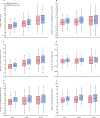A community-based, multi-level, multi-setting, multi-component intervention to reduce weight gain among low socioeconomic status Latinx children with overweight or obesity: The Stanford GOALS randomised controlled trial
- PMID: 33933181
- PMCID: PMC8241238
- DOI: 10.1016/S2213-8587(21)00084-X
A community-based, multi-level, multi-setting, multi-component intervention to reduce weight gain among low socioeconomic status Latinx children with overweight or obesity: The Stanford GOALS randomised controlled trial
Abstract
Background: There are few long-term studies of interventions to reduce in low socioeconomic status children with overweight or obesity. The Stanford GOALS trial evaluated a 3-year, community-based, multi-level, multi-setting, multi-component (MMM) systems intervention, to reduce weight gain among low socioeconomic status, Latinx children with overweight or obesity.
Methods: We did a two-arm, parallel group, randomised, open-label, active placebo-controlled trial with masked assessment over 3 years. Families from low-income, primarily Latinx communities in Northern California, CA, USA, with 7-11-year-old children with overweight or obesity were randomly assigned to a MMM intervention or a Health Education (HE) comparison intervention. The MMM intervention included home environment changes and behavioural counselling, community after school team sports, and reports to primary health-care providers. The primary outcome was child BMI trajectory over three years. Secondary outcomes included one- and two-year changes in BMI. This trial is registered with ClinicalTrials.govNCT01642836.
Findings: Between July 13, 2012, and Oct 3, 2013, 241 families were recruited and randomly assigned to MMM (n=120) or HE (n=121). Children's mean age was 9·5 (SD 1·4) years, 134 (56%) were female and 107 (44%) were male, and 236 (98%) were Latinx. 238 (99%) children participated in year 1, 233 (97%) in year 2, and 227 (94%) in year 3 of follow-up assessments. In intention-to-treat analysis, over 3 years, the difference between intervention groups in BMI trajectory was not significant (mean adjusted difference -0·25 [95% CI -0·90 to 0·40] kg/m2; Cohen's d=0.10; p=0·45). Children in the MMM intervention group gained less BMI over 1 year than did children in the HE intervention group (-0·73 [-1·07 to -0·39] kg/m2, d=0.55); the same was true over 2 years (-0·63 [-1·13 to -0·14] kg/m2; d =0.33). No differential adverse events were observed.
Interpretation: The MMM intervention did not reduce BMI gain versus HE over 3 years but the effects over 1 and 2 years in this rigorous trial show the promise of this systems intervention approach for reducing weight gain and cardiometabolic risk factors in low socioeconomic status communities.
Funding: US National Institutes of Health.
Copyright © 2021 Elsevier Ltd. All rights reserved.
Conflict of interest statement
Declaration of interests TNR serves on scientific advisory boards for WW International. DMW has received grant funding and serves on a scientific advisory board for Tolerion, on an advisory board for the California Institute for Regenerative Medicine, and on a data and safety monitoring board for Intrexon T1D Partners. JS has received funding from Weight Watchers. All other authors declare no competing interests.
Figures



Comment in
-
Tackling childhood obesity in low-socioeconomic status communities: what is the next step?Lancet Diabetes Endocrinol. 2021 Jun;9(6):320-321. doi: 10.1016/S2213-8587(21)00110-8. Epub 2021 Apr 29. Lancet Diabetes Endocrinol. 2021. PMID: 33933182 No abstract available.
References
-
- Dietz WH, Robinson TN. Overweight Children and Adolescents. New England Journal of Medicine 2005;352:2100–9. - PubMed
-
- Dietz WH. We Need a New Approach to Prevent Obesity in Low-Income Minority Populations. Pediatrics 2019;143. - PubMed
-
- Ho M, Garnett SP, Baur L, et al. Effectiveness of lifestyle interventions in child obesity: systematic review with meta-analysis. Pediatrics 2012;130:e1647–71. - PubMed
Publication types
MeSH terms
Associated data
Grants and funding
LinkOut - more resources
Full Text Sources
Other Literature Sources
Medical

